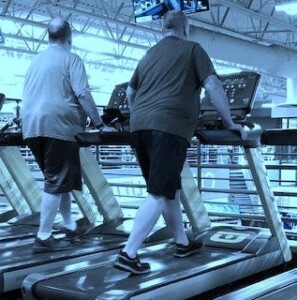
Do you hold onto the treadmill? Are you aware this may ruin your posture & eventually cause hip problems?
It’s bad for the hips & spine, especially for older people.
Even long before I became a certified personal trainer, I was aware of how so many people cling to the side rails, or front bar, of the treadmill when they walk on it.
Holding onto the treadmill is just wrong, wrong, wrong, wrong, wrong–no matter what your age.
No matter what kind of gym I went to, whether it was a gym at a hotel, a rec center, or a large chain health club gym, most treadmill users would always be holding on, and I don’t mean for a brief heart rate check, either.
People hold on for the entire duration of their walking (sometimes jogging) session. This is not a smart thing to do.
Some of you already know it’s wrong but continue to do it anyways. But the vast majority, based on me speaking to people as a personal trainer, simply have no clue that this is the wrong way to walk.
When you walk, your walking posture is supposed to be upright, in alignment, and your arms are supposed to be swinging rhythmically at your side.
When a person holds fast to the treadmill, this natural rhythm is completely disrupted, far fewer calories are burned than if the person was not holding on, and the legs do not get a true walking workout.
Furthermore, holding on diminishes a person’s natural balancing ability, and makes the body less efficient at walking.
Holding on causes the hips to over-rotate to compensate for the lack of upper body movement. This over-rotation, over time, can cause repetitive stress injuries to the hips. Beware.
So how does one break this useless habit?
And that’s really exactly what it is: a useless habit. It’s not something only old people do. It’s not something that only obese people do. Look around. People of all ages hold on. What are they afraid of? Beats me.
People of all body types and sizes hold on: thin, medium, heavy, obese; short, tall; muscular, curvy, scrawny, you name it.
Anyone can break this harmful habit (it can cause repetitive stress injuries in the hips, and aggravate pre-existing back problems).
It’s all a matter of selecting a speed that you can handle without fearing you’re going to fall off. Most treadmills go as slow as one-half mile per hour. How can you fall of that?
I’ve found that the average, typical person can handle the speed they normally hold on at, without holding on, assuming there is no incline.
So if you’re holding on at 3.5 mph, simply let go.
If you’re afraid to (this is all psychological), then slow down first, then let go. Every minute, increase the speed a little, until you are up to 3.5 mph or whatever you normally do.
Some people, however, do have the speed set too fast for their abilities, walking at 4.7 mph while clinging fast to the front bar.
This can really throw the hips out of whack, and even though this is a fast speed, you’re not really, truly walking.
You are holding onto something. How can you really be walking? Slow the speed!
Same with the incline; people have it set to high for the speed, then grasp the front bar and lean their bodies back.
This is not walking. Either set that incline lower, or slow the speed, so that you can manage it without holding on.
Holding on is a bad, bad habit, the most common I see at health clubs everywhere. Even if you’re older, you must retrain yourself to walk correctly on a treadmill.
























